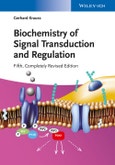Originally based on a graduate course taught by the author, this true classic has once again been extensively updated to incorporate key new findings in biological signaling. With over half of the content re-written, plus 70 brand new and 50 revised figures, this is the most up-to-date textbook on signaling available anywhere.
Thanks to its clear structure, hundreds of illustrative drawings, as well as chapter introductions and newly added study questions, this text excels as a companion for a course on biological signaling, and equally as an introductory reference to the field for students and researchers. Generations of students and junior researchers have relied on "the Krauss" to find their way through the bewildering complexity of biological signaling pathways.
Table of Contents
BASICS OF CELL SIGNALINGCell Signaling: Why, When and Where?
Intercellular Signaling
Hormones in Intercellular Signaling
Intracellular Signaling: Basics
Molecular Tools for Intracellular Signaling
PROPERTIES OF SIGNALING PROTEINS AND ORGANIZATION OF SIGNALING
Modular Structure of Signaling Proteins
Modular Signaling Complexes
Regulation of Signaling Enzymes by Effector Binding
Posttranslational Modifications in Cellular Signaling
Regulation by Phosphorylation
Protein Lysine Acetylation
Protein Methylation
Ubiquitin Modification of Proteins
Lipidation of Signaling Proteins
Scaffold Proteins
Organization of SignalingTHE REGULATION OF GENE EXPRESSION
The Basic Steps of Gene Expression
The Components of the Eukaryotic Transcription Machinery
The Principles of Transcription Regulation
The Control of Transcription Factors
Chromatin Structure and Transcription Regulation
RNA PROCESSING, TRANSLATIONAL REGULATION AND RNA INTERFERENCE
Pre-mRNA Processing
Regulation at the Level of Translation
Regulation by RNA Silencing
SIGNALING BY NUCLEAR RECEPTORS
Ligands of Nuclear Receptors
Principles of Signaling by Nuclear Receptors
Structure of Nuclear Receptors
Transcriptional Regulation by Nuclear Receptors
Regulation of Signaling by Nuclear Receptors
Subcellular Localization of Nuclear Receptors
Non-Genomic Functions of Nuclear Receptors and their LigandsG PROTEIN-COUPLED SIGNAL TRANSMISSION PATHWAYS
Transmembrane Receptors: General Structure and Classification
Structural Principles of Transmembrane Receptors
G Protein-Coupled Receptors
Regulatory GTPases
The Heterotrimeric G-Proteins
Receptor-Independent Functions of Heterotrimeric G-Proteins
Effector Molecules of G-Proteins
GPCR Signaling via Arrestin
INTRACELLULAR MESSENGER SUBSTANCES: "SECOND MESSENGERS"
General Properties of Intracellular Messenger Substances
cAMP
cGMP and Guanylyl Cyclases
Metabolism of Inositol Phospholipids and Inositol Phosphates
Storage and Release of Ca2+
Functions of Phosphoinositides
Ca2+ as a Signal Molecule
Diacylglycerol as a Signal Molecule
Other Lipid Messengers
The NO Signaling Molecule
SER/THR-SPECIFIC PROTEIN KINASES AND PROTEIN PHOSPHATASES
Classification, Structure and Characteristics of Protein Kinases
Structure and Regulation of Protein Kinases
Protein Kinase A
The PI3 Kinase/Akt Pathway
Protein Kinase C
Ca2+/Calmodulin-Dependent Protein Kinases
Ser/Thr-specific Protein Phosphatases
SIGNAL TRANSMISSION VIA TRANSMEMBRANE RECEPTORS WITH TYRSINE-SPECIFIC PROTEIN KINASE ACTIVITY
Structure and Function of RTKs
Downstream Effector Proteins of RTKs
Nonreceptor Tyrosine-Specific Protein Kinases, Non-RTKs
Protein Tyrosine Phosphatases
Adaptor Molecules of Receptor Tyrosine Kinases
SIGNAL TRANSMISSIO VIA RAS PROTEINS
The Ras Superfamily of Monomeric GTPases
GTPase-Activating Proteins, GAPs, of the Monomeric GTPases
Guanine Nucleotide Exchange Factors, GEFs, of the Monomeric GTPases
Inhibitors of Guanine-Nucleotide Dissociation, GDIs
The Ras Family of Monomeric GTPases
Raf Kinase as an Effector of Signal Transduction by Ras Proteins
Further Ras Family Members: R-Ras, Ral and Rap
Reception and Transmission of Multiple Signals by Ras Protein
The Further Branches of the Ras Superfamily
INTRACELLULAR SIGNAL TRANSDUCTION: THE PROTEIN CASCADES OF THE MAP KINASE PATHWAYS
Organization and Components of MAPK Pathways
Regulation of MAPK Pathways by Protein Phosphatases and Inhibitory Proteins
Specificity in MAPK Activation and Organization in Multiprotein Complexes
The Major MAPK Pathways of Mammals
MEMBRANE RECEPTORS WITH ASSOCIATED TYROSINE KINASE ACTIVITY
Cytokines and Cytokine Receptors
The Jak-Stat Pathway
T and B Cell Receptors (TCRs and BCRs)
Signal Transduction via Integrins
OTHER TRANSMEMBRANE RECEPTOR CLASSES: SIGNALING BY TGFÃ-RECEPTORS, TNF-RECEPTORS, TOLL-RECEPTORS AND NOTH
TGFÃ Receptor and Smad Protein Singaling
Receptor Regulation by Intramembrane Proteolysis: The Notch Receptor
Tumor Necrosis Factor Receptor (TNFR) Superfamily
Toll-Like Receptor Signaling
CELL CYCLE CONTROL BY EXTERNAL SIGNALING PATHWAYS
Principles of Cell Cycle Control
Key Elements of the Cell Cycle Apparatus
Regulation of the Cell Cycle by Proteolysis
G1 Progression and S Phase Entry
Transit Through S-Phase and M-Phase
The DNA Damage and DNA Replication Checkpoints
MALFUNCTION OF SIGNALING PATHWAYS AND TUMORIGENESIS: ONCOGENES AND TUMOR SUPPRESSOR GENES
Basic Characteristics of Tumor Cells
Mutation in Cancer Cells
Common Physiologic Changes in Tumor Cells: The Hallmarks of Cancer
Signaling Proteins Mutated in Cancer: Oncogenes
Tumor Suppressor Genes: General Functions
The Tumor Suppressors Rb and ARF
APOPTOSIS
Overview of Apoptotic Pathways
Caspases: Death by Proteolysis
The Family of Bcl-2 Proteins: Gatekeepers of Apoptosis
The Mitochondrial Pathway of Apoptosis
Death Receptor-Triggered Apoptosis
Links of Apoptosis to Cellular Signaling Pathways








